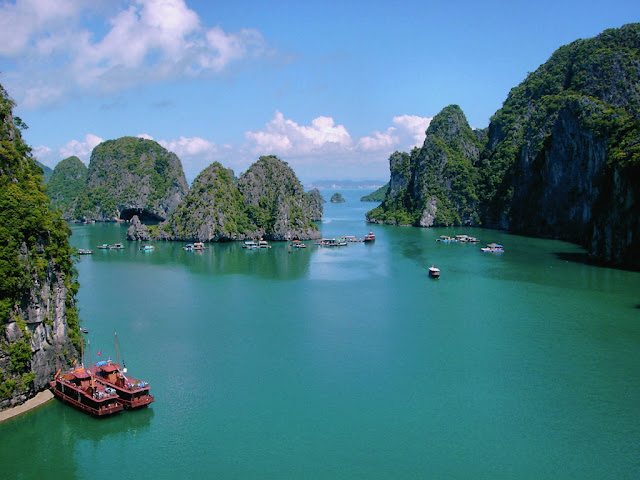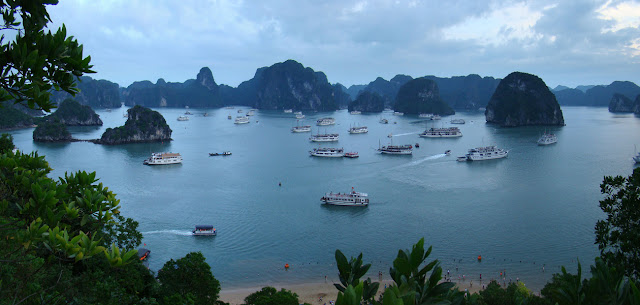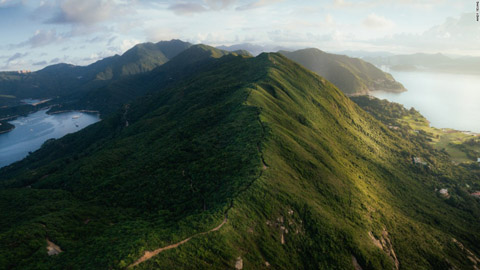Ha Long Bay of Viet Nam
Overview of Ha Long Bay
Hạ Long Bay (Vietnamese: Vịnh Hạ Long,literally: “descending dragon bay”) is a UNESCO World Heritage Site and popular travel destination in Quảng Ninh Province, Vietnam. Administratively, the bay belongs to Hạ Long City, Cẩm Phả town, and is a part of Vân Đồn District. The bay features thousands of limestone karsts and isles in various shapes and sizes. Ha Long Bay is a center of a larger zone which includes Bái Tử Long Bay to the northeast, and Cát Bà Island to the southwest. These larger zones share a similar geological, geographical, geomorphological, climate and cultural characters.
Hạ Long Bay has an area of around 1,553 km2, including 1,960–2,000 islets, most of which are limestone. The core of the bay has an area of 334 km2 with a high density of 775 islets. The limestone in this bay has gone through 500 million years of formation in different conditions and environments. The evolution of the karst in this bay has taken 20 million years under the impact of the tropical wet climate. The geo-diversity of the environment in the area has created biodiversity, including a tropical evergreen biosystem, oceanic and sea shore biosystem. Hạ Long Bay is home to 14 endemic floral species and 60 endemic faunal species.
Location
Hạ Long Bay is located in northeastern Vietnam, from E106°56' to E107°37' and from N20°43' to N21°09'. The bay stretches from Yên Hưng district, past Hạ Long city, Cẩm Phả town to Vân Đồn District, bordered on the south and southeast by the Gulf of Tonkin, on the north by China, and on the west and southwest by Cát Bà Island. The bay has a 120 km long coastline and is approximately 1,553 km² in size with about 2,000 islets. The area designated by UNESCO as the World Natural Heritage Site incorporates 434 km² with 775 islets, of which the core zone is delimited by 69 points: Đầu Gỗ island on the west, Ba Hầm lake on the south and Cống Tây island on the east. The protected area is from the Cái Dăm petrol store to Quang Hanh commune, Cẩm Phả town and the surrounding zone.
Weather
The climate of the bay is tropical, wet, sea islands, with two seasons: hot and moist summer, and dry and cold winter. The average temperature is from 15 °C- 25 °C, and annual rainfall is between 2 meters and 2.2 meters. Hạ Long Bay has the typical diurnal tide system (tide amplitude ranges from 3.5-4m). The salinity is from 31 to 34.5MT in the dry season and lower in the rainy season.
History
History shows that Hạ Long Bay was the setting for local naval battles against Vietnam's coastal neighbors. On three occasions, in the labyrinth of channels in Bạch Đằng River near the islands, the Vietnamese army stopped the Chinese from landing. In 1288, General Trần Hưng Đạo stopped Mongol ships from sailing up the nearby Bạch Đằng River by placing steel-tipped wooden stakes at high tide, sinking the Mongol Kublai Khan's fleet.
During the Vietnam War, many of the channels between the islands were heavily mined by the United States Navy, some of which pose a threat to shipping to this day.
Ancient tales
Hạ Long bay's inhabitants have developed numerous tales explaining names given to various isles and caves in the bay.[22]
Đầu Gỗ cave (literally: "the end of wooden bars" cave): these wooden bars in this cave are the remnants of sharped wooden columns built under the water level by the order of Trần Hưng Đạo commander in order to sink Mongolian invaders' ships in the 13th century.
Kim Quy cave (literally: "Golden Turtle" cave): it is told that the Golden Turtle swam toward the Eastern Sea (international name: South China Sea) after returning the holy sword which had assisted King Lê Thái Tổ in the combat against Ming invaders from China. Next, with the approval of the Sea King, Golden Turtle continued to fight against monsters in this marine area. The turtle became exhausted and died in a cave. Consequently, the cave was named after the Golden Turtle.
Con Cóc isle (literally: Frog isle): is a frog- like isle. According to ancient tales, in a year of severe drought, a frog directed all animals to the Heaven and protested against the God. They demonstrated in favour of making rain. As a result, the God must accept the frog as his uncle. Since then, whenever frogs grind their teeth, the God has to pour water down the ground.
Food
1. Chả Mực (Squid Ball – Squid Cake)
Halong Squid Ball is well known not only for Vietnamese but also for international tourists. The main ingredient is, of course, squid. However, not any kind of squid can make the dish as wonderful as Halong Bay's freshly caught squid. The dish, hence, will get the sharp and appealing tang. The crunchy yet chewy texture, juicy taste and attractive aroma of Squid Ball go well with boiled rice, sticky rice or Bánh Cuốn (a type of thin, steamed rice cake). This darling is sold at many stores and stalls around the city and especially at Halong I Market.
2. Snail
Visiting any random snail restaurant/street shop in Halong City, gourmets might be surprised with a very long list of different exotic snails there. Each species possesses distinctive appearance and a very distinctive flavour. All you can do is being adventurous, trying a random dish that catches your eyes or with a local, who can show you the difference among the snails. Good shops for snail can be found at Vuon Dao road, Bai Chay ward (but a bit pricey) or in Hon Gai area, where not only snail but various types of fresh and cheap seafoods are sold.
3. Ngán (A type of hard clam)
If you have a chance to have just one bite of Ngán, its deliciousness would stay in your mouth forever. Amongst all dishes made from Ngán, the most famous one is Ngán wine, which is made by opening the shells of Ngán then letting its blood flow directly into the strong liquor. Visiting Halong, you may have many Ngán dishes like grilled, steamed, sushi, salad, soup, deep-fried with vegetables, porridge, etc. You should not miss the chance to experience this unique seafood when you come to Halong Bay.
4. Prawn and Lobster
With good environment, Halong Bay is blessed with many kinds of prawn, lobster, white pearl shrimp, or tiger shrimp. However, the most valuable and most delicious are prawn and lobster. There are two popular methods of prawn/lobster processing, steaming and breaded frying. However, steaming with using additional ingredients like beer or tubers lemongrass to remove the fishy smell is more preferable because people love to enjoy the natural taste it provides.
5. Oyster
Another well-known seafood in Halong Bay is oyster. Oyster is a nutrition-rich food and provides a plethora of energy for your body. Inside its hard-shell is blood-like red bowel, which carry the most delicious and nutritious part of an oyster. It can be eaten raw with a lemon slice or grilled with cheese.
The crunchy yet chewy texture, juicy taste and attractive aroma of Squid Ball go well with boiled rice, sticky rice or Bánh Cuốn (a type of thin, steamed rice cake)
6. Sá Sùng (A type of sea worm)
This rare and expensive speciality only exists in Quan Lan Island, Minh Chau Island (Van Don, Quang Ninh). Fresh Sá Sùng stir-fried with garlic is a rustic way of cooking of Halong people. Or you can try to taste roasted Sá Sùng, a golden crispy dish with aromatic odour, combined with herb and a glass of beer. Nowadays, this delicacy is brought from the 2 mentioned islands to Halong City, so you are able to taste it right at the city but the price is quite high in compare to other types of seafoods due to its rarity.
7. Bánh Gật Gù (Nodding Rice Cake)
Bánh Gật Gù is made from steaming rice flour mixture. When eating, the cake is dipped in a special sauce, along with a piece of caramelized pork. The feeling of cool, soft cake and juicy pork can enchant even the fastidious customers.
8. Hà (A type of tiny rock clam)
Another proud specialty of Halong is Hà. Hà clam can be made to a delicious sour soup all around four seasons of the year, but most interesting time to eat this soup is still the hot summer days. In addition, Hà can be covered in wheat flour and deep-fried, bringing out a rich and savory taste.
9. Sam Quảng Yên (Horseshoe Crab of Quang Yen)
The meat of Sam can be processed into a lot of different foods, such as pudding crab, crab salad, sweet and sour crab legs, crab sauté with peppers and lemongrass, fried eggs crab, steamed crabs, fried crab, fried crab’s cartilage, stir-fried crab and glass noodle. The endless menu of horseshoe crab is always await the visitors in Halong.
10. Cà Sáy Tiên Yên
Cà Sáy is a hybrid between muscovy and duck, inheriting the taste of both meat kind. Through the Tiên Yên people’s processing method, it becomes doubly delicious. The secret is the aromatic sauce made from fish sauce of Cai Rong, Van Yen, Cat Hai, sassafras concentration of Guangxi and mild spicy ginger grown on Tiên Yên soil.
Make sure to have a full experience to Halong Bay through enjoying all the specialties included in this list!
keyword: niceplaceworld, nice place on world, nice place, beatutiful place, nice scene, nice scenery, beautiful scene, travel, travel vietnam, beautiful vietnam, https://niceplaceworld.blogspot.com/








No comments:
Post a Comment